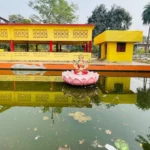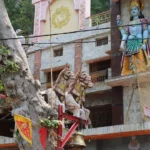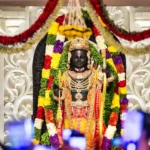Historical Background of Jhansi Fort
Jhansi Fort, an architectural marvel perched on a rocky hill in the north of Jhansi city, holds a significant place in the tapestry of Indian history. The origins of this formidable structure trace back to the early 17th century, credited to Raja Bir Singh Deo of Orchha in 1613.
Built atop a hillock known as Bangira, the fort dominates the cityscape, offering a panoramic view of the town below, a strategic advantage that was crucial during times of war.
The fort’s architecture is a testament to the ingenuity and foresight of its builders. Sprawling over a massive 15 acres, the walls of the fort, constructed with granite, are a formidable barrier, standing tall against the ravages of time and war.
The fort is surrounded by a deep moat, which was once filled with water, to thwart enemy advances. The fortification comprises ten gates (Darwazas), each with its own unique story and architectural style, including the Khandero Gate, Datia Darwaza, Unnao Gate, and Orchha Gate among others.
Inside, the fort is a maze of historical treasures, with buildings that have their own tales to tell. The Ganesh Mandir, dedicated to Lord Ganesha, is where Rani Laxmi Bai is believed to have married Maharaja Gangadhar Rao Newalkar.

The Shiva temple, located at the entrance, is another spiritual oasis, offering solace and a glimpse into the spiritual life of the fort’s inhabitants. The Kadak Bijli cannon, mounted on a tower, is a symbol of the military prowess of the fort. It was used in the battle of 1857 and stands as a testament to the intense warfare that took place.
But the fort’s history isn’t just about its architecture and military significance; it’s deeply intertwined with the socio-political dynamics of the region. Jhansi Fort came under the rule of the Marathas in the 18th century and later saw the reign of the British East India Company. This period was marked by political unrest and shifting allegiances, setting the stage for one of the most tumultuous times in Indian history.
As the stronghold of the kingdom of Jhansi, the fort was not just a centre of military strategy but also a hub of cultural and administrative activities. Its walls have witnessed grand ceremonies, the formulation of crucial political strategies, and the echoes of the footsteps of some of the most notable figures in Indian history.
In the next section, we’ll delve into the life of the fort’s most illustrious resident, Rani Laxmi Bai, and how her extraordinary life became an integral part of the legacy of Jhansi Fort. Her story is not just a chapter in the history of the fort but a source of inspiration, echoing the fort’s resilience and indomitable spirit.
Rani Laxmi Bai: A Symbol of Bravery and Courage
Rani Laxmi Bai, born Manikarnika Tambe in 1828 in Varanasi, is more than just a historical figure; she’s an emblem of valour and defiance in the face of adversity. Her life story is a poignant narrative of bravery, strategic acumen, and an unyielding desire for independence.
Early Life and Marriage – Jhansi Fort
Manikarnika, fondly known as Manu in her childhood, was known for her unconventional upbringing. Under the tutelage of her father, Moropant Tambe, she was trained in horseback riding, fencing, and shooting, skills unusual for the women of her time. Her education was not confined to just martial training; she also received a comprehensive education in the scriptures and the administrative workings of a state, laying the foundation for her future role as the Queen of Jhansi.
In 1842, Manu was married to Maharaja Gangadhar Rao Newalkar, the King of Jhansi, and was thereafter known as Rani Laxmi Bai. Her marriage marked the beginning of a new chapter in her life, bringing her into the political sphere of Jhansi. As queen, she managed the affairs of the state with the same acumen and grace as she wielded a sword, earning the respect and admiration of her subjects.
Ascension to the Throne and the Adoption of Damodar Rao
The death of Maharaja Gangadhar Rao in 1853 was a turning point in Laxmi Bai’s life. With her husband’s demise, the British East India Company applied the Doctrine of Lapse, a policy that allowed them to annex states without a male heir. However, the Maharaja and Rani Laxmi Bai had adopted a son, Damodar Rao, on the day before the Maharaja’s death. Rani Laxmi Bai vehemently protested against the British refusal to recognize her adopted son’s rights to the throne and her own right to rule as regent during his minority.

Her resistance against the British was not just a struggle for her kingdom but a fight for the rightful recognition of her adopted son. Her famous proclamation, “I will not give up my Jhansi,” was not just a declaration of her intent to fight but a symbol of her unwavering commitment to her people and her land.
The Warrior Queen
Rani Laxmi Bai’s transformation from a queen to a warrior is a narrative of extraordinary courage and strategic prowess. As the winds of the Indian Rebellion of 1857 began to stir, she took the reins of Jhansi’s defence into her hands. She recruited and trained an army, fortified the city’s defences, and formed alliances, preparing Jhansi to face the imminent British onslaught.
Her leadership during this tumultuous period was marked by a blend of wisdom, foresight, and courage. She was not just a figurehead; she was a leader who led from the front, inspiring her troops with her bravery and her commitment to her land and people.
In the next section, we will recount the epic Siege of Jhansi and how Rani Laxmi Bai’s leadership, tactical acumen, and indomitable spirit became the cornerstone of her legacy, turning Jhansi Fort into an enduring symbol of resistance and bravery.
The Siege of Jhansi and Rani Laxmi Bai’s Leadership
The year 1857 marked a defining moment in Indian history – the outbreak of the Indian Rebellion against British rule. Amidst this backdrop of unrest and upheaval, the Siege of Jhansi emerged as one of the most pivotal chapters, showcasing Rani Laxmi Bai’s strategic brilliance and unyielding spirit.
The Prelude to the Siege
As the flames of rebellion spread across India, Jhansi initially remained relatively calm. Rani Laxmi Bai, despite her personal grievances against the British annexation policies, managed the affairs of her state with a focus on stability and prosperity. However, the winds of change were inevitable.
When the rebellion reached the neighbouring areas, Jhansi too was engulfed in turmoil. Stories of atrocities committed by the rebelling sepoys elsewhere fueled fear among the British residents in Jhansi. Despite assurances of safety from Rani Laxmi Bai, a tragic massacre of the British in Jhansi occurred, an event over which the Rani had little control. This incident, however, marked her as a rebel in the eyes of the British and set the stage for the siege.
The Siege and the Defense of Jhansi
In March 1858, the British forces, led by Sir Hugh Rose, laid siege to Jhansi. The fort, with its formidable defences, was a challenge even for the well-equipped British army. Rani Laxmi Bai, in preparation for the assault, had fortified the city, rallied her troops, and even enlisted the support of the local population.
The siege was brutal and relentless. The British, armed with heavy artillery, bombarded the walls of Jhansi Fort. Inside the fort, Rani Laxmi Bai led the defence with extraordinary bravery and strategic acumen. She donned the attire of a soldier and fought alongside her troops, inspiring them with her courage and determination. The battles were fierce, and the streets of Jhansi witnessed intense combat.

Despite being outnumbered and facing a formidable enemy, the resistance put up by the defenders of Jhansi was fierce and unwavering. Rani Laxmi Bai, with her leadership and military skills, managed to hold off the British forces for a considerable time. However, the superior military might of the British eventually overwhelmed the defenders.
The Escape and Legacy of Bravery
As the situation inside the fort grew dire, Rani Laxmi Bai made a daring decision. In a bold and heroic escape, she strapped her adopted son Damodar Rao to her back, mounted her horse, and leapt off the fort’s walls. The leap not only saved her and her son but also symbolized her indomitable spirit and refusal to surrender.
Though Jhansi fell to the British, the story of its defence, led by Rani Laxmi Bai, became a symbol of resistance and courage. Her bravery during the siege, her leadership in the face of overwhelming odds, and her dramatic escape have been etched into the collective memory of India, inspiring countless generations.
In the next section, we will explore the cultural and historical legacy of Rani Laxmi Bai and Jhansi Fort, delving into how her spirit of resistance and the fort’s resilience have been commemorated and celebrated through the years.




























